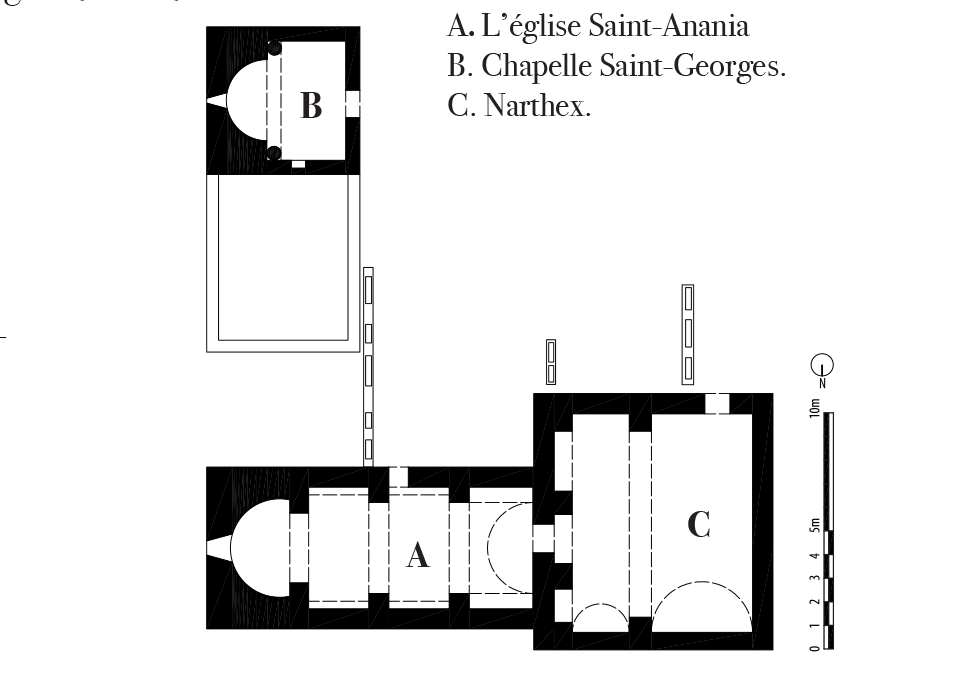The monastery of Saint Anania stands at 38°25’N and 42°10’ E in the village of Bor [Değirmenaltı], north of Paghesh [Bitlis] on a right-hand fork of the Tadwan [Tatvan] road. A short distance away and above the village is a second monastery, Saint John (Surp Hovhannes), which has also been called simply Bor monastery (Bora Vank‘).
The Saint Anania monastery is mentioned in 1418 as Saint Anania (Surp Anania), and as Saint George in the colophon of a manuscript produced there, and is found again in 1575; but judging by the form and various architectural features, the church is a paleo-Christian edifice dating from the 5th-6th centuries. The small Saint John oratory (Surp Hovhannes) in the second monastery is attributed to the 7th century, but underwent later restorations. The Saint John oratory is mentioned in 1578 and 1584. The two establishments were certainly considered to form a whole before Saint Anania came into use as the local parish church.

Stèle à croix datée de 1496, 2012 (Coll. Maguesyan).
The church of Saint Anania was renovated in 1466 and sometime in the same century was given a narthex. A narthex was also built in front of the church of Saint John. In the 15th century Bor and its religious establishments flourished, as attested by more than a dozen cross-stones dating from this period, among which several giant steles. The scriptorium remained active throughout the 16th century, but declined in the 17th. Bor was home to two important figures. The first was Arak‘el of Paghesh (Arak‘el Paghichetsi), an early 15th-century author and pupil of the scholar Gregory Dzerents (Krikor Dzerents, † 1421) in Khlat‘ [Ahlat] (the former rector of the monastic university of Ardzwaper; see n° 7), who later became abbot of the monastery of the Great Walnut Trees (n° 62). The second important figure was Mgrditsh Naghash († c. 1473), poet, copyist and illuminator, appointed bishop of “Amida (Dikranaguerd [Diyarbakır]) and Mesopotamia” in 1430, who was responsible for the construction, on the slopes of the Arghën [Ergani] fortress of the monastery of the Holy Mother of God of the Sweeping View (n° 67). In the second half of the 19th century, a single monk was administrator of the monastery, its plow lands and grazing lands, and the parish of Bor.
The Saint Anania (A) monastery is composed of the church of the same name, a large single-vessel nave measuring 18.3 × 8..4 m with two transverse arches, lateral niches under arches with pitched roofs; and on the west side a transverse narthex (C) with twin aisles, 12.2 × 13.3. The monastery also includes a chapel (B) located nearby to the south, which corresponds perhaps to the dedication to Saint George mentioned in the 15th- and 16th-century texts. The monastery of Saint John includes an oratory measuring 6.2 × 4 m, extended 8.3 m to the west by a transverse narthex with twin aisles opening on the south side into a courtyard. The complex is completed by several rows of cross-stones, extending from the south wall of the church of Saint Anania and from its narthex; these steles, some of which are as much as 4 m in height, date – for those bearing dates – from 1449, 1456, 1496 and 1513. One can also see a cross-stone in the church of Saint John.

Plan (Thierry, 1989, 358, modifié)
The monasteries of Saint Anania and Saint John of Bor were both confiscated after the Great War and turned into warehouses. In the 1970s, both narthexes could still be seen, even though they had partially collapsed; today however they have all but disappeared. Nearly all the carefully laid ornamental stones of Saint Anania have been removed as have the covering slabs. A wall has been built outward from the south façade behind the third row of cross-stones, while a new building has just been erected a meter from the tall stones in the first row. The chapel attributed to Saint George lies in ruins. In the village a piece of cross-stone has been used as a fountain. The stele of Saint John, on the other hand, has completely disappeared.
Oskian, 1940-1947, III [1947], 941-943. Thierry, 1989, 367-365. Devgants, 1985, 101.